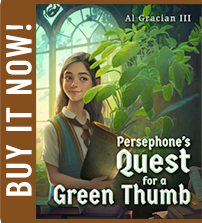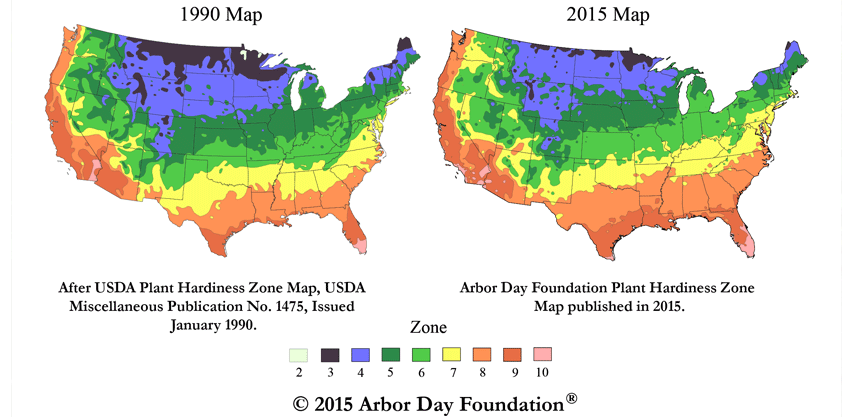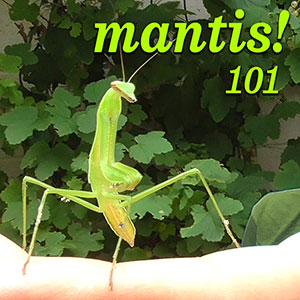Why Native Plants Aren't Always Better & Why Non-natives Aren't Always Invasive
Have you had some overzealous conservationist tell you that the flowers, herbs, ground-covers or shrubs in your yard are "invasive"? Since they aren't "native" plants, you are essentially destroying the environment by harboring rogue plants that are sapping the life out of everything around them. You have both a civic and even a moral duty to quickly right your wrongs by yanking out all of your ornamental landscape and converting it to a meadow of native wildflowers. If the Monarch butterflies die, it's all going to be your fault.
Well-intentioned conservationists and the groups they work for seem to have banded together to create an almost cultist religion. They try to force-feed a very narrow minded vision of how we should be cultivating our land. Time and again you may read the same sweeping generalizations, rife with double-talk. The goal is to put all "native" species on a pedestal while vilifying any and all plants that don't measure up to this arbitrary standard. Let's get real here: This is not a simple, cut and dry matter. Native plants may offer many benefits, but not always. And non-natives deserve much more respect than they are given.
- Defining Natives vs Non-Natives & Invasives:
- What Are Native vs Non-native / Exotic Species?
- What Are Invasive Plants?
- Are Native Plants Invasive?
- What Are Noxious Weeds?
- Comparing Natives to Non-Natives:
- Are Native Plants Better?
- The Advantages of Native Plants vs Non-natives
- Why Are Non-native Plants Bad?
- Why It's OK to Plant Non-Invasive, Non-Natives
- The Benefits of Non-native Plants
- Why Conservationists Are Wrong About Natives
- Should You Grow Non-Natives or Just Natives?
Defining Natives vs Non-Natives & Invasives:
What Are Native vs Non-native / Exotic Species?
NATIVE PLANTS: What's the difference between native and non-native species? What really makes a plant "native"? There are many definitions for the term native. But most commonly, a native plant species is any indigenous plant that has been naturally living in a geographic region and was not introduced by human activity. Here in North America, the time-frame used as a reference point, is European colonization. Although indigenous peoples may have brought plants with them as they spread across the land, it is only when Europeans appeared that we began tracking what plants are "new" or introduced. The ones that had already been embedded in the ecosystem are "natives."
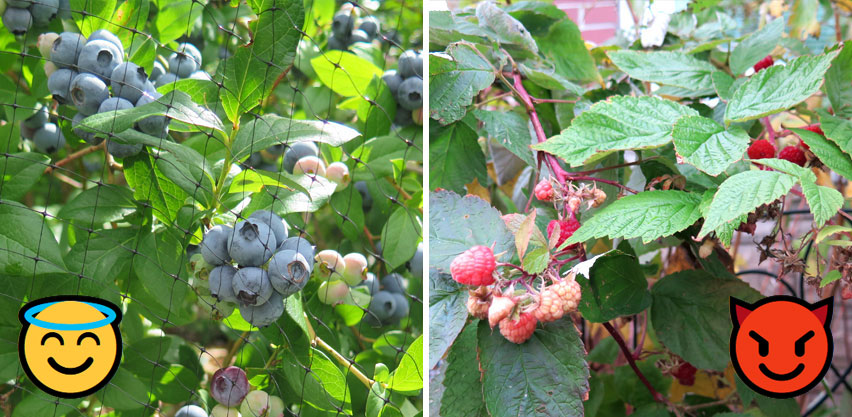
Although blueberries are US natives, these red raspberries are European, making them non-natives.
NON-NATIVE PLANTS: Thus by default, any plant that arrived after colonization is considered a "non-native." A common definition is that a non-native plant is one that was introduced to a specific region by direct or even indirect human activity. Focusing on the human element raises questions about weather events and migratory animals. These can just as easily spread seeds and new plant material into an area. If human intervention is intrinsic, does that mean that novel seeds blown in by a hurricane can be considered "natives"? Humans were not involved after all. For that reason, some organizations will simply look at what plants were in a certain site before European contact. Anything that arrived after that point is a "non-native."
EXOTIC PLANTS: This same definition refers to exotic plants. For example, the EPA defines exotic plants as: "A plant that is not born, growing, or produced naturally (native) in an area, region, or country. Syn. non-indigenous plant." So the terms "non-native," "exotic," "alien" and "non-indigenous" are synonymous and can be used interchangeably.
Regardless of which term you use, a crucial element seems to be this reference point: European colonization. As you look at what should or shouldn't be grown in an area, remember that people are trying to freeze an ecosystem in time. This entire classification system is based on the way things were more than 500 years ago.
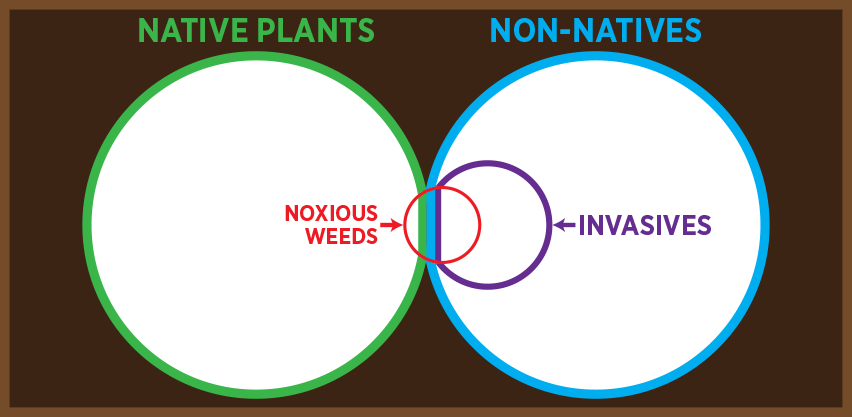
There are thousands of native and non-native plant species. Most are not invasives or noxious weeds.
What Are Invasive Plants?
INVASIVE ≠ NON-NATIVE PLANTS: Probably the worst conflation promoted by misguided conservationists is the tendency to misuse the term "invasive". It is incorrect to equate invasive species with non-native species. What is an invasive species and how does that differ from a non-native? When used anecdotally, the term invasive might be used to describe any type of plant that exhibits aggressive growth characteristics. But this is not the proper definition when classifying a species.
According to the USDA, "As per Executive Order 13112 (Section 1. Definitions) an 'invasive species' is a species that is: 1) non-native (or alien) to the ecosystem under consideration and, 2) whose introduction causes or is likely to cause economic or environmental harm or harm to human health."
When looking at the federal definition, it's clear that an invasive plant must cause actual harm or at least have the potential to do so. Some plants are dangerous to human health. Some are toxic to livestock. Plants that threaten agricultural production can result in economic loss. Some plants spread so aggressively that they cause environmental harm by destroying biodiversity. They may even outcompete native plants or animals to the point of extinction. These are all detrimental impacts that result in the classification of "invasive."
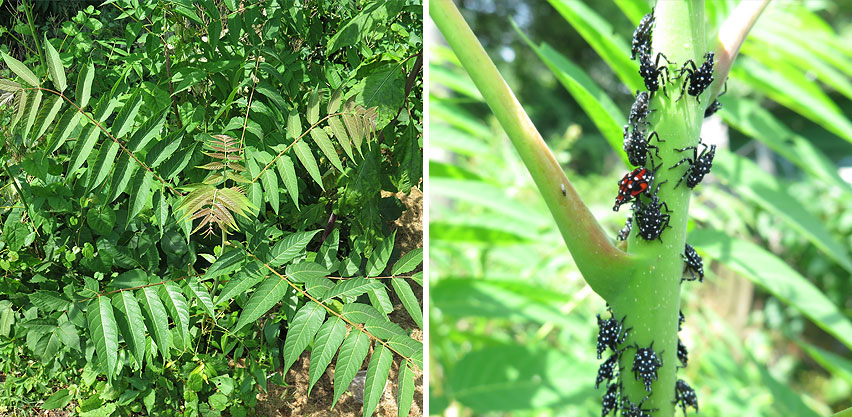
The highly invasive Tree-of-Heaven (Ailanthus altissima) attracts invasive spotted lanternfly pests.
On the other hand, most non-natives do not result in such harm or losses. So it is wholly inappropriate to refer to them as invasive. The word invasive has such a negative connotation that it is often misused as a pejorative. Anyone who refers to all non-natives as invasives is either trying to create an emotionally charged response, or they are simply ignorant of the clear distinction between those terms.
Are Native Plants Invasive?
Accordingly, it is impossible for any native plant to be classified as invasive, regardless of how aggressive its growth might be. It might be harmful to humans but that doesn't matter. According to Executive Order 13112 all invasive plants are inherently non-native. However, not all non-natives can be designated as "invasive." In fact, most non-natives are not invasive. In the US, the federal government has an educational list of invasive species. In addition to federal classifications, various states also have lists of invasive plants that are threats to each region.
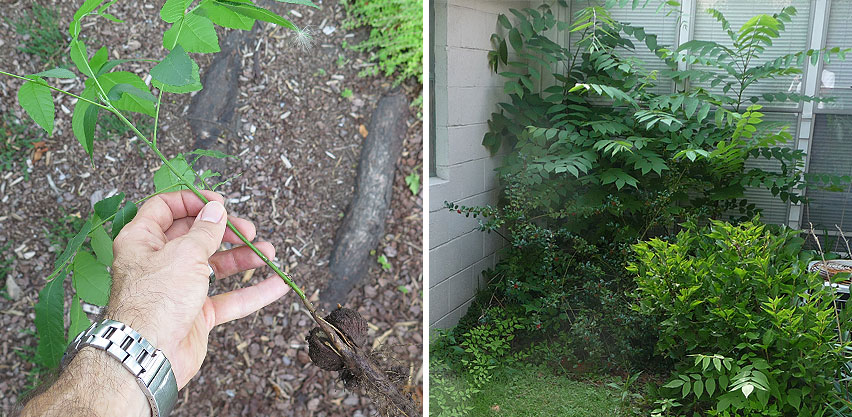
Native black walnuts are extremely vigorous. Their juglone chemical can be toxic to other plants. But they're not invasives.
What Are Noxious Weeds?
NOXIOUS WEEDS: Although there's plenty of talk about invasive species, many resources completely omit the existence of "Noxious Weeds." In the United States, The Plant Protection Act (PPA) contains a list of plants (7 CFR 360.200) which have been designated as noxious weeds. According to this federal statute, a noxious weed is: "Any plant or plant product that can directly or indirectly injure or cause damage to crops (including nursery stock or plant products), livestock, poultry, or other interests of agriculture, irrigation, navigation, the natural resources of the United States, the public health, or the environment."

St. John's Wort is a classic herbal remedy. But it's toxic to livestock & considered invasive. Some states list it as a noxious weed.
The USDA Field Guide to Noxious and Invasive Weeds notes that "Noxious weeds generally possess one or more of the following characteristics: aggressive and difficult to manage, poisonous, toxic, parasitic, a carrier or host for serious insects or disease, and being native or new to or not common to the United States or parts thereof."
There are three priority classes. Class A and Class B Noxious Weeds are non-native. Interestingly, Class C Noxious Weeds include both non-native AND native plants. So while some natives could be classified noxious weeds, they would not be considered invasive.
Federal and state designated noxious weeds are heavily regulated. These plants are considered on a case by case basis and determined to be in need of strict controls. For example, Federal noxious weeds cannot be moved into or through the US or interstate without a special permit. This makes perfect sense because such plants are typically shown to be detrimental to our economy, society or environment.
Comparing Natives to Non-Natives:
Are Native Plants Better?
Hands down, whether it's government websites or just random bloggers, the entire internet is going to tell you that native plants are better. Get native plants. Avoid non-natives. Natives will save the world. There are several core arguments made in favor of native plants. Let's consider them one by one:
- ADAPTED TO SURVIVE: Native plants naturally grew and evolved with the climate and soils where they are found. This has allowed them to adapt to the weather patterns and moisture conditions of their native range. Thus, they are hardier, healthier plants, equipped to survive frosts and drought. 🤔 This must mean that non-natives all die. Zero cold tolerance. No drought resistance. If the plant originated in a different continent, then it is incapable of withstanding the growing conditions in your area.
- EASY TO MAINTAIN: Because native plants are uniquely suited to their geography, they are able to grow with little need for human inputs. Natives require less water, fertilizer or pesticides. They simply need to get established and then you barely need to do anything. Apparently non-natives are the exact opposite. They constantly need watered and fertilized. They are always plagued by insects and need sprayed all of the time. If you see a sick or diseased plant in your neighborhood, rest assured, it's definitely a non-native. 🙄
- FOOD SOURCE FOR BIRDS: Native plants provide berries, seeds and insects which birds can feed upon. Non-natives do not. They don't produce fruits or seeds and insects won't touch them. 😏 That's why birds are only capable of surviving off plants that are indigenous to their area. Birds refuse to eat any berries or seeds from plants that were introduced by Europeans. Caterpillars might be found on non-native plants but, due to their pride, birds have been known to starve to death rather than resorting to eating a tainted caterpillar.
- ATTRACTS POLLINATORS: Native plant species attract native bees, butterflies, moths, beetles, and hummingbirds. But such pollinators are quick to discern if a plant originated in Europe, Africa or Asia. Although it might make lots of pollen and may be dripping with nectar, strict union laws prohibit beneficial insects from approaching non-native flowering plants. 🤣
- SUPPORTS NATIVE BIODIVERSITY: We've destroyed much of our natural habitats through deforestation, industrial agriculture, suburban sprawl, climate change and pollution. As result, we need you to plant a milkweed plant in that three foot bed in front of your house. It's the only way to balance things out and restore the natural habitats of our ecosystem. 😱 But if you choose to grow a non-native plant instead, you will further seal our fates and thousands of species will likely go extinct. No pressure.
- PROVIDING SHELTER FOR WILDLIFE: Various mammals, birds and insects rely upon native vegetation for their habitat. Most people know about host specific plants like milkweeds or butterfly weeds which monarch butterfly larvae require exclusively. But apparently this applies to all native species. Non-native plants are useless when it comes to native habitat. In cities where non-native trees are planted, it's common to find birds living in back allies in cardboard boxes since zoning regulations prevent them from inhabiting non-native trees. 🤪
The Advantages of Native Plants vs Non-natives:

Birds like chickadees require a reliable food source to raise their young.

Common Milkweed (Asclepias syriaca) and Butterfly Weed (Asclepias tuberosa) are native flowers that support pollinator populations such as this Great Spangled Fritillary Butterfly.

An Eastern Black Swallowtail Butterfly and a Monarch Butterfly Caterpillar Feed on Butterfly Weed.
Video: Native Bird Nest in My Non-native Tree!
What's going on!? I thought that you need NATIVE plants to be able to provide habitat for native birds.Why Are Non-native Plants "Bad"?
As you consider all of the purported benefits of native plants, the clear message is that non-natives are just not as good. They are consistently framed as being weakly and incapable of survival without all sorts of intensive inputs. That would seem to be the reason they are so bad.
I find it odd though that these frail, non-resilient plants are simultaneously portrayed as being invasive plants that are impossible to control. Somehow these weak plants require lots of maintenance when grown on your property. But once they get out into the wild, they create dense uncontrollable monocultures, suppressing all the native plants in their vicinity. They smother out tree saplings and trigger the complete decline of all native wildlife and insects. That's an impressive feat for plants that are supposedly poorly adapted to that region.
Conservationists cite invasive species when trying to make an argument against non-natives in general. But that's not how it works. There are plenty of non-native plants that are healthy, trouble-free plants. And at the same time, they aren't overly aggressive and harmful to the point of being invasive. Invasive plants represent a small minority of the non-native plant community. But most arguments fixate on invasives and try to project their traits onto non-natives as a whole.
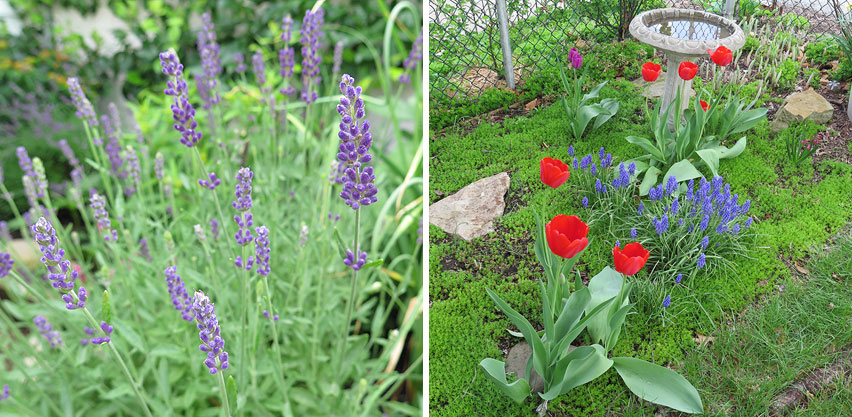
Lavender & tulip flowers are non-natives but they're easily controlled in the garden.
All the while, there's this persistent dichotomy of portraying non-natives as poorly adapted while somehow being able to spread prolifically. This type of double-talk pops up time and again. A healthy, vigorous native plant is a good thing. But a healthy vigorous non-native is bad, and proves that it must be invasive. Don't worry though, "a healthy vigorous non-native" is an oxymoron. After all, non-natives are sickly and struggle to survive...
So are non-natives really bad? No, of course not! There are many non-native plants that serve crucial functions in our ecosystems. Not only do they benefit wildlife, but they also benefit us. Just walk down the produce aisle in your grocery store and you'll see all sorts of non-natives that we eat every day.
Invasive plants and noxious weeds are the real bad guys. But vilifying all non-natives because of a few rogue invasives is really a form of prejudice. Anyone who tries to discount all non-native plants as being valueless or even harmful, is really displaying plant bigotry. In a society that pushes "tolerance" more than ever, I'm amazed to read the narrow-minded propaganda pushed by some conservationists.
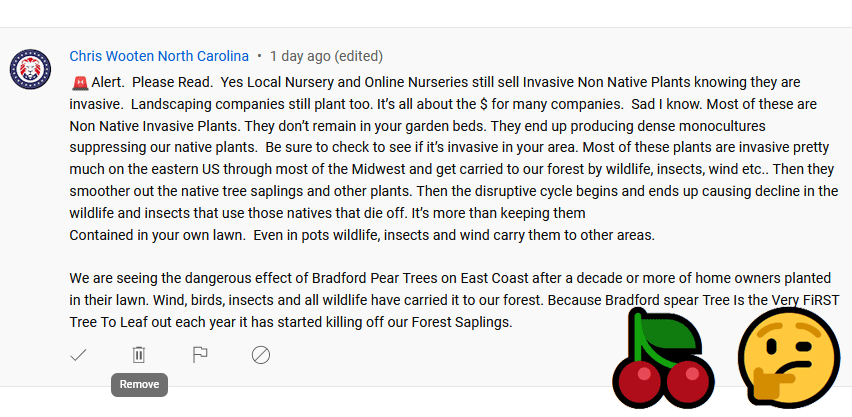
Misguided alarmists invoke a single invasive plant to disparage ALL non-natives, often misusing the term "invasive."
Their arguments are based on sweeping generalizations. They prop up native plants as being pure and impeccable. Then they paint non-natives as the polar opposite. When challenged to substantiate their claims, they cherry pick some random invasive plant as though it somehow represents every plant that has crossed our borders in the last 500 years. It's botanical xenophobia, plain and simple. Rather than educating the public, such oversimplification is really a disservice.
Why It's OK to Plant Non-Invasive, Non-Natives
I don't promote the use of any plants which the US government officially classifies as noxious weeds. In addition to national designations, there are individual states which may or may not consider a plant to be invasive. Plants can behave differently from one region to another, so it's good to understand how a species responds to your local conditions. Such plants might have some tangible benefits, but those are overshadowed by serious drawbacks and risks. So if your governmental agency warns you to steer clear of a certain plant, then please do so. This especially applies to those which are legally classified as noxious weeds. But these represent a minority of some 25,000 non-native plant species found in the US. Of those, about 5,000 are established in US ecosystems. Ultimately, very few non-native plants ever become invasive.
- NON-NATIVE PLANTS FEED MILLIONS: Most of us rely heavily on non-native plants for our very survival. Americans consume cultivated food crops like oats, wheat, rice and potatoes. All of these happen to be non-native plants in the US. Peaches, apples, oranges and peanuts wouldn't be grown in the US if we only focused on growing "native" crops. If I only grew natives in my backyard garden, I'd waste hundreds of dollars buying garlic, asparagus, tomatoes, peppers, cucumbers & zucchini at the grocery store. Growing these non-native vegetables at home saves me money and it also reduces my personal reliance on commercial agricultural.
- BENEFICIAL NON-NATIVE HERBS: Parsley, dill, sage, oregano, thyme, rosemary, lemon balm, bay leaf and curry tree are all non-native spices and culinary herbs that I grow right in my garden. Some are perennials, coming back year after year. Volunteers might pop up from seeds that have been spread through my yard. But they never become uncontrollable. These plants help with cooking. But they also beautify my property. Aromatics like lavender add colors and smells that stimulate the senses. A purely native garden would be missing all of these.
- INSECTS & POLLINATORS LOVE NON-NATIVES: According to the National Audubon Society, "Yards With Non-Native Plants Create 'Food Deserts' for Bugs." But I've personally seen that this claim is too generalized to carry any weight. All through the growing season, I'll see pollinators springing to action as each plant comes into bloom. The bees love my US natives like agastache, maypop incarnata, milkweed, butterfly weed, aronia and echinacea. But they don't stop there. They're more than happy to visit my oregano, lavender, lemon balm, rugosa roses, European raspberries and peaches. All of my non-native annual vegetables enjoy a constant queue of bees, wasps and other pollinators who work diligently to ensure good fruit set. The native paper wasps rather enjoy the non-native cabbage butterfly larvae found munching on my non-native kale. When my non-native lettuce get inundated by aphids, I can count on my native ladybugs to come to the rescue.
- NON-NATIVE PLANTS FEED BIRDS & WILDLIFE: The Audubon Society would paint the picture that native birds cannot feed on non-natives plants. But this is false! I've personally witnessed cardinals or robins eating my nanking cherries and goumi berries, even though the plants are of Asian origins. I've seen the birds completely strip my European red currants. I also spotted little seed cobs at the base of my jujube tree where some native rodent (probably a squirrel) had been munch on fruit after fruit. If given the chance, deer would gladly mow down the fresh shoots on my rugosa rose.
- NON-NATIVE PLANTS CAN BE HEALTHY & ADAPTIVE: Plenty of non-native plants grow well with zero fertilizer inputs. Nitrogen fixing plants like goumis grow quite well in sub-standard soil. In drought stricken areas, there are non-native Mediterranean plants like lavender, thyme, sage and oregano are excellent candidates for xeriscaping. Some non-native fruit trees are late to leaf out and bloom. Jujubes and Asian Persimmons are able to avoid damage from late frosts and are great for growing in climates that get increasingly hot. I don't live on the coastline, but I need the plants in my back alley to have good salt tolerance. Despite the spray from salt trucks, my non-native rogusa roses hold up even better than many native species.
- NON-NATIVE PLANTS CAN BE EASY TO CONTROL: I live hundreds of miles inland, away from the coast. So my rugosa rose has been extremely easy to manage. In my spot, it's not invasive what-so-ever. I've found my native passion fruit vine to be extremely hard to control once established. However, my non-native hardy kiwi vine (Actinidia arguta 'Issai') is much more controllable. The variety I selected is self-fruitful. Being less vigorous, it stays put and gives me zero issues, just a lot of tasty fruits. Some beneficial non-native plants are even sterile, so you never need to worry about them escaping cultivation. My Bocking 14 Russian comfrey is great for building soil fertility. The bees like the flowers. But it won't self sow, making it easy to manage. There are plenty of non-natives that grow well, but not too well. Why don't conservationists want to acknowledge them?
- NON-NATIVE PLANTS INCREASE BIODIVERSITY: Conservationists claim to be concerned about biodiversity. They try to associate native plants with monocultures. Immediately you might think of a sea of air potato vines or Japanese kudzu. Perhaps you driven past endless rows of Japanese knotweed. These are prime examples of invasive plants at their worst. But restricting thousands of benign non-natives isn't going to do anything to boost biodiversity. In fact, the very opposite occurs. There are many non-native plants that are well suited for growing alongside native species. The inclusion of these additional species would obviously INCREASE biodiversity, not decrease it.
The Benefits of Non-native Plants:
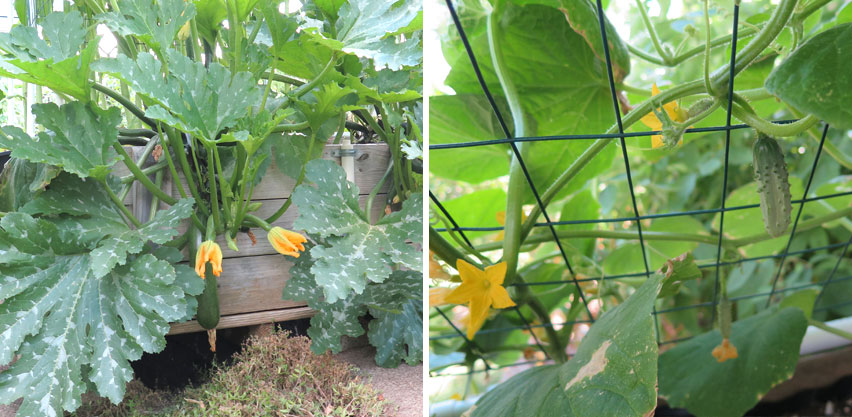
Zucchini & cucumber plants might not be natives but the bees visit the flowers as they bloom all Summer.

Although asparagus is not native to the US, ladybugs have no problems using it as habitat.

This swallowtail caterpillar is feeding on non-native dill as the butterfly enjoys a hybrid Oriental Stargazer lily.
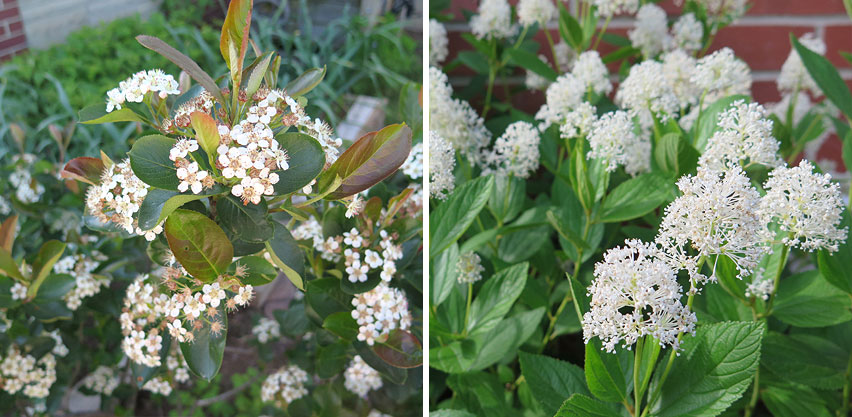
Some native flowering shrubs like Aronia and New Jersey Tea have a very limited flowering window.
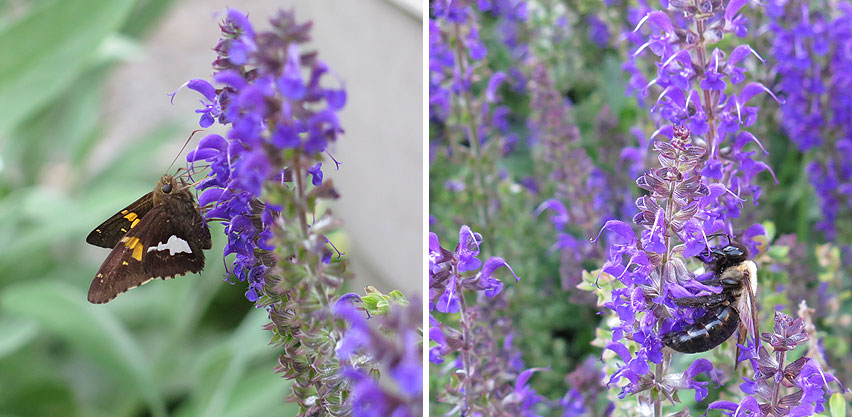
This non-native flower Salvia nemorosa 'Blue Hill' feeds butterflies & bees all Summer long.
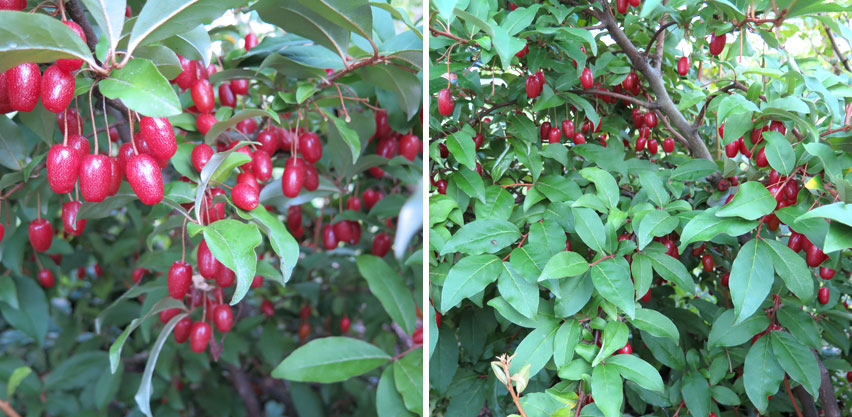
Goumi berry bushes fix their own nitrogen and don't need fertilized. Plus the native birds love the berries!
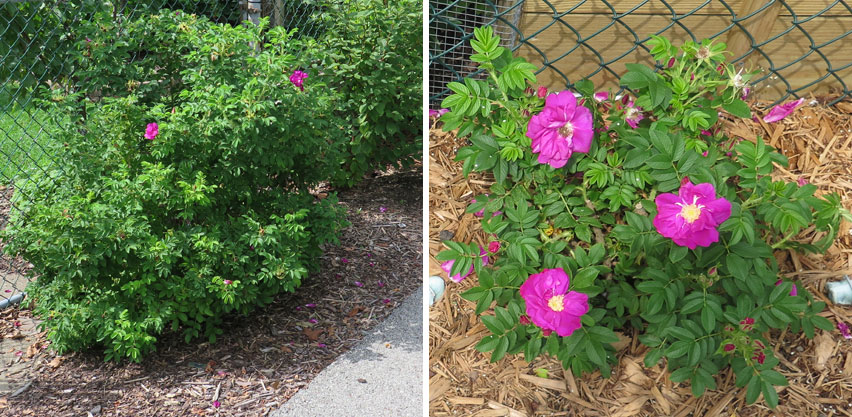
This non-native healthy rugosa rose is planted along a side street where salt is applied every Winter.

My native passion fruit vine (left) is MUCH harder to control than my non-native hardy kiwi vine (right).
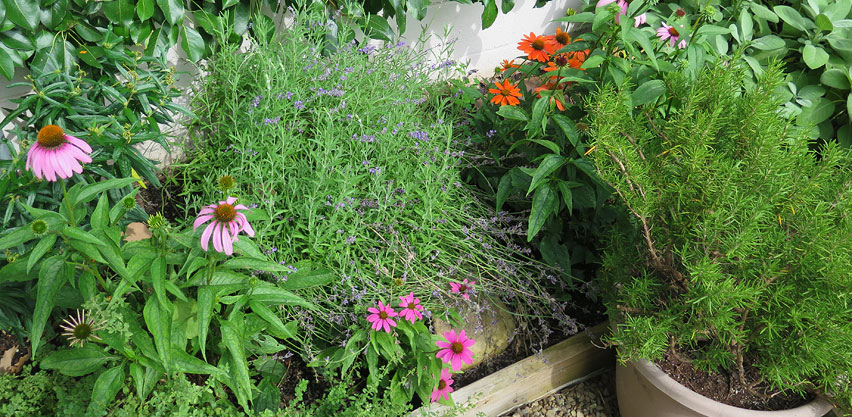
My pollinator, herbal garden has natives AND non-natives: Echinacea, Lavender, Sage, Rosemary & Thyme.
Clearly, there are some non-native plants that can serve vital uses for humans and their surrounding ecosystems. You just need to pick the right ones. And that's the crux of the issue. Societies should stop discriminating against entire plant categories purely on the basis of origins. Although such sweeping measures might be applicable on a wildlife or nature reserve, they are impossible in the context of food cultivation. And I propose that property owners should not have those biases forced upon them either. Instead, each plant selected for a site should be well vetted and selected on the basis of its useful characteristics. Obviously, this requires more effort. It's easier to simply check a box saying "native" without putting any other thought into the process.
Why Conservationists Are Wrong About Natives
Video: Native Vine:
Maypop (Passiflora Incarnata)
Highly Aggressive Growth!
If my passionfruit vine wasn't known to be "native," conservationists would clamor to brand it as highly "invasive."
- NATIVE PLANTS CAN BE HARMFUL: Just because a plant is native, that doesn't mean it's problem-free. Poison ivy is native to many areas in the US. But it can cause extremely harmful effects to humans who are exposed to the urushiol in its plant parts. The plant can be so toxic that humans have died after inhaling the smoke produced while burning it. Some overly righteous conservationists will promote its "benefits" to wildlife. But let's be real. If it was a non-native plant, it would be listed as a Class A noxious weed both federally and at every state level. Fortunately some localities like New York City require the eradication of poison ivy. But too many government agencies give it a free pass because of its status as an untouchable native (pun intended).
- NATIVE PLANTS CAN BE 'INVASIVE': Although native plants are not classified officially as invasive, they can exhibit growth characteristics that are just as aggressive as their non-native counterparts. Take for example, the maypop passion-flower vine (Passiflora incarnata). I have this "native" plant on my property. It produces beautiful flowers and a delicious tropical tasting fruit. But the plant is the most 'invasive' aggressive growing plant on my property. It sends out vigorous root suckers that travel many feet from the original planting location. I found a vine popping up through a crack in my garage floor. It had traveled 15 feet underneath a concrete slab before finally emerging! It had to dig a 2 foot deep trench to create a rhizome barrier just to keep it in check.
- NATIVE PLANTS ARE NOT ALWAYS BEST ADAPTED: A core backbone of arguments favoring native plants is that they are uniquely adapted to a certain region. Whether it's wet soil, drought, infertile soil, cold climate or hot climate, conservationists paint the picture that a non-native plant couldn't possibly handle it. But whatever the environment, you can find analogs in spot after spot all around the world. This has been empirically demonstrated by various non-natives that grow so well as to become invasive. There are LOTS of non-natives that could easily replace a native and require no additional inputs. That's why natives are sometimes outcompeted. If they had such a superior survival advantage, then they would never be under threat.
- NATIVE RANGES CHANGE AS CLIMATE CHANGES: The entire premise of "natives" vs "non-natives" is based on an arbitrary snapshot in time. Plant populations and their ranges are always compared to the way things were 500 years ago. But things have changed a lot since then. For better or worse, there are new fauna that didn't used to live here. They are part of an ever-changing food web and ecosystem. So why shouldn't we expect to see new flora as well?
Then add to this the fact that the climate has changed quite a bit since 1492. In 2012 the USDA updated its plant hardiness zones map. Things had changed since the previous revision 22 years earlier. And 10 years later the climate has changed even more. This has altered the native ranges of animals. Shouldn't plant ranges shift as well? That means NEW plants showing up in NEW areas where they hadn't ever been before. Ecosystems have always been dynamically adaptive, not static systems. It's time to wake up and take a more pragmatic approach rather than rely on a sentimentality that borders religious fervor.
Simply being a native plant should not be the gold standard.

This plant hedge is completely overgrown with "native" but toxic poison ivy.
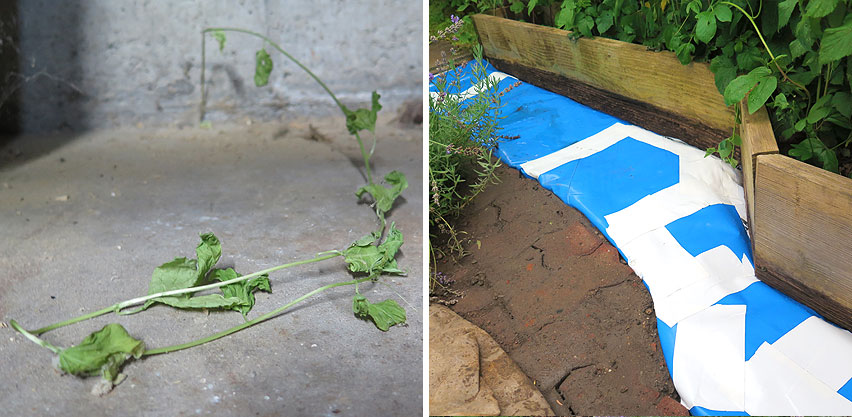
Controlling the native passion fruit has been extremely challenging!
Should You Grow Non-Natives or Just Natives?
What types of plants should you be growing on your property? That's the real question isn't it? I'm not going to address policies intended for public land management. Strategies for managing national parks, state parks or nature reserves are one thing. I'm more concerned about the pressures being put on private citizens. If you personally want nothing but native wild flowers on your lot, then go for it. It should be your decision. But that's certainly not my approach.

My small property provides abundant food & plenty of habitat for beneficial wildlife.
I practice edible landscaping and urban gardening. I select plants according to my needs as a human. Secondly, I consider what I can do for beneficial insects and other wildlife. Make no mistake though, I'm trying to feed myself and my family. I don't grow plants just to feed groundhogs, squirrels, rabbits and deer. I actively create barriers to keep them out. If I didn't put up bird netting around my native blueberries, I wouldn't be able to harvest 5 gallons every year.
I have excellent biodiversity on my property. I enjoy native and non-native fruit trees, bushes and vines. I get heavy yields from my annual vegetables. My flower and herb beds have a perfect balance of both natives and non-natives. I require zero pesticides. My water requirements are minimal. The plants are healthy. And the wildlife can't seem to stay away.
But that's my approach. Do what works for you. Avoid plants that are truly invasive or noxious. Consider some of the native plants in your area that might be appealing. Whether a plant is native or non-native though, you need to take time to learn about it. Giving undue deference to a plant based on its native status could easily cloud your judgment. You might opt for a sub-optimal species purely because it happens to be native. Instead, focus on what matters: How beneficial will that specific plant be at your specific site? What conditions will help it to thrive? Pick the right plant. Put it in the right place. And you'll get the best results.
Our gardens don't need to be purely native for us to connect with all the living things sharing our neighborhood. Kids and adults can have a high-quality educational experience right in their own backyard. And the experience is further enhanced if we take time to expand our knowledge, learning about the benefits that non-native plants can offer.
